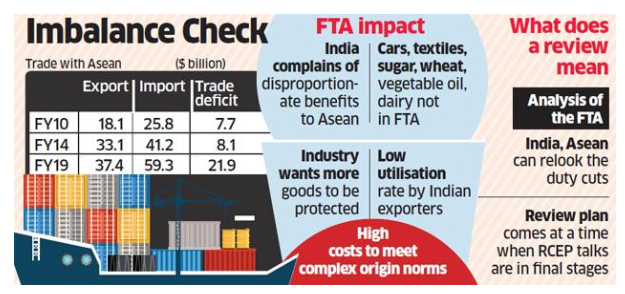The Big Picture- RSTV
India-ASEAN FTA
Archives
TOPIC: General Studies 2
- Bilateral, regional and global groupings and agreements involving India and/or affecting India’s interests
In News: India and the 10-member ASEAN have agreed to initiate a review of the bilateral free trade agreement (FTA) in goods to make it “more user-friendly, simple and trade facilitative”. India is not happy about the fact that its trade deficit with ASEAN has widened significantly since the pact was implemented in January 2010.
The Situation

- A NITI Aayog study reveals that India’s trade deficit with ASEAN doubled to $10 billion in 2017 from $5 billion in 2011.
- A review of the India-ASEAN FTA could help improve utilisation in India by making the pact simpler and more user-friendly.
- Policymakers hold the view that FTAs have adversely impacted India’s manufacturing, which the government is trying to boost through its Make in India initiative in order to generate jobs.
- Liberalisation under the India-Asean FTA covers 75% of the two-way trade. India kept around 10% of tariff lines in exclusion. These included motor vehicles, textiles, petroleum products, sugar, wheat, vegetable oil dairy products and other food products. However, Thailand, Philippines, Myanmar, Brunei and Vietnam kept a higher number of tariff lines under exclusion.
- Moreover, the surge in goods imports into India is accentuated by instances of non-adherence to origin norms and lack of full cooperation in investigating and addressing such breaches.
- In contrast, the utilisation of preferential tariffs by India under the India-Asean FTA is below 30% because of standards, regulatory measures and other non-tariff barriers in the region. Ships, boats, floating structures, mineral fuels, mineral oils and meat are India’s largest exports to the grouping while telecom equipment, electrical machinery, mineral fuels, mineral oils and animal or vegetable fats and oils are the biggest imports.
The challenge is not merely tariff barriers, but also non-tariff barriers applied by most member countries including China. Market access has become more challenging than tariffs itself, even among member countries. India has the lowest non-tariff barriers in the region and China the highest. RCEP comprises a quarter of global gross domestic product, 30% of global trade, 26% of foreign direct investment flows, and 45% of the world’s population.
The Decision
In the joint statement, the Ministers welcomed the recommendations of the ASEAN-India Business Council to further promote the potential of bilateral trade through the utilisation of the ASEAN-India FTA as well as cooperation in some areas of mutual interest, such as financial technology, connectivity, start-ups and innovation, empowerment of youth, and women and MSME development.
India has also pushed to include the Automatic Trigger Safeguard Mechanism or ATSM. This will automatically increase levies once imports cross a given threshold. This is in addition to reviewing the Free Trade Agreement (FTA) with ASEAN and other members.
- The review will help bring back manufacturing and it will also go a long way towards Make in India, helping our agriculture and bring more manufacturing and jobs to India
- The review would definitely help in creating a more equitable trade agreement that would help in the revival of these sectors
Regional Comprehensive Economic Partnership (RCEP)
- It is a proposed free trade agreement (FTA) between ASEAN and its six FTA partners – China, Japan, India, South Korea, Australia and New Zealand.
- RCEP negotiation was formally launched in 2012, whose member states together account for 3.4 billion people and approximately 40% of world’s GDP.
Members of Indian Industry are resisting RCEP due to following concerns:
- Flooding of the market with Chinese goods impacting domestic manufacturers
- Lack of access to Indian services in the RCEP countries (Services is India’s strong area and has huge potential to tap into RCEP market)
Ten member states of ASEAN are Brunei, Cambodia, Indonesia, Laos, Malaysia, Myanmar, the Philippines, Singapore, Thailand, Vietnam
Must Read: Link 1
Connecting the Dots:
- What are India’s interests in the ASEAN? Examine the measures taken by the government to strengthen Indo-ASEAN cooperation.














